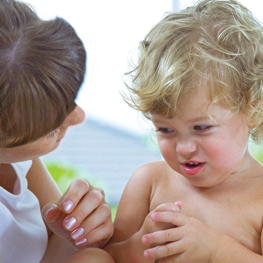Time-ins versus time-outs. What's the difference? As it turns out, quite a bit. Many adults are familiar with the concept of time-outs, the process of separating the child (withholding attention, the highest motivator for any child) from their parents (often in another part of the house, if home) for the purpose of calming down, thinking about their behavior and regrouping. Overused, time-outs can quickly become ineffective and both the parent and the child can feel bad about the experience.
 Time-ins, similar to time-outs, focus on teaching the child to self-regulate their behavior. However, time-ins also emphasize regaining peace and balance of the situation, while the child is within close proximity to their parent. And this physical closeness while calming helps to foster connection and security between the child and the parent.
Time-ins, similar to time-outs, focus on teaching the child to self-regulate their behavior. However, time-ins also emphasize regaining peace and balance of the situation, while the child is within close proximity to their parent. And this physical closeness while calming helps to foster connection and security between the child and the parent.
There are a several things a parent needs to be ‘on board’ with to effectively use time-ins. The first is that they should understand what discipline is - the training or teaching that reinforces the desired specific behavior (self-regulation) and ordered way of life compatible with family and societal expectations. The second is that the parent should embrace a new attitude, that of being child-centered (what the child needs), and focus on how to best address that.
The use of time-ins is well-suited to any child, and can be used for a child of any age. Parents who are bonded with their child are the most effective because their child is attuned to them (emotionally connected).
The parent can explain why the behavior was inappropriate after the child has calmed down, but only if they themselves are calm. Parents who are emotional cannot help their child or address situation.
To use time-ins effectively:
Other do’s and don'ts:
Judy M. Miller, MA, is an author, parenting and adoption educator, and mother of four. She makes a point of enjoying the journey.
Calgary’s Child Magazine © 2024 Calgary’s Child